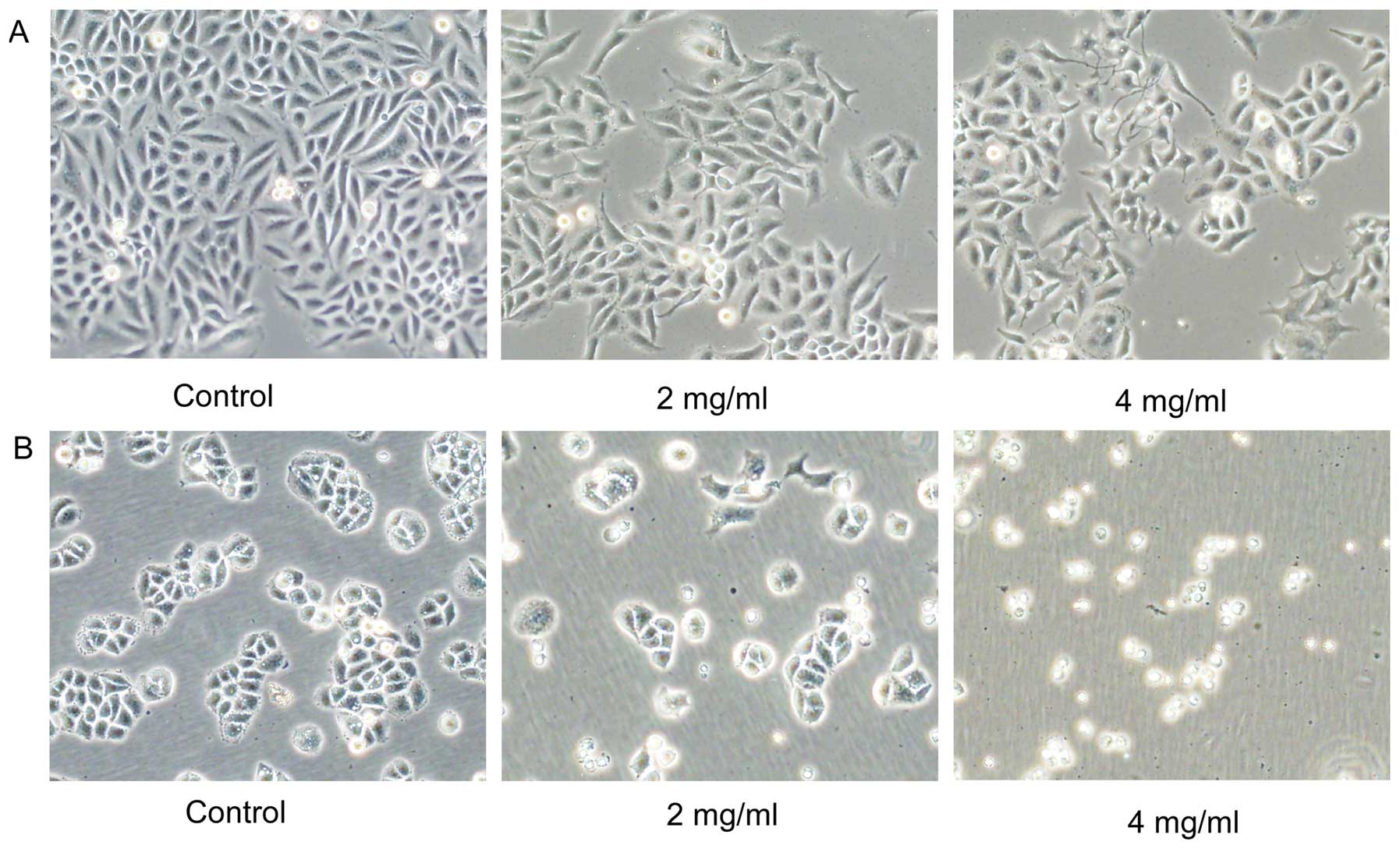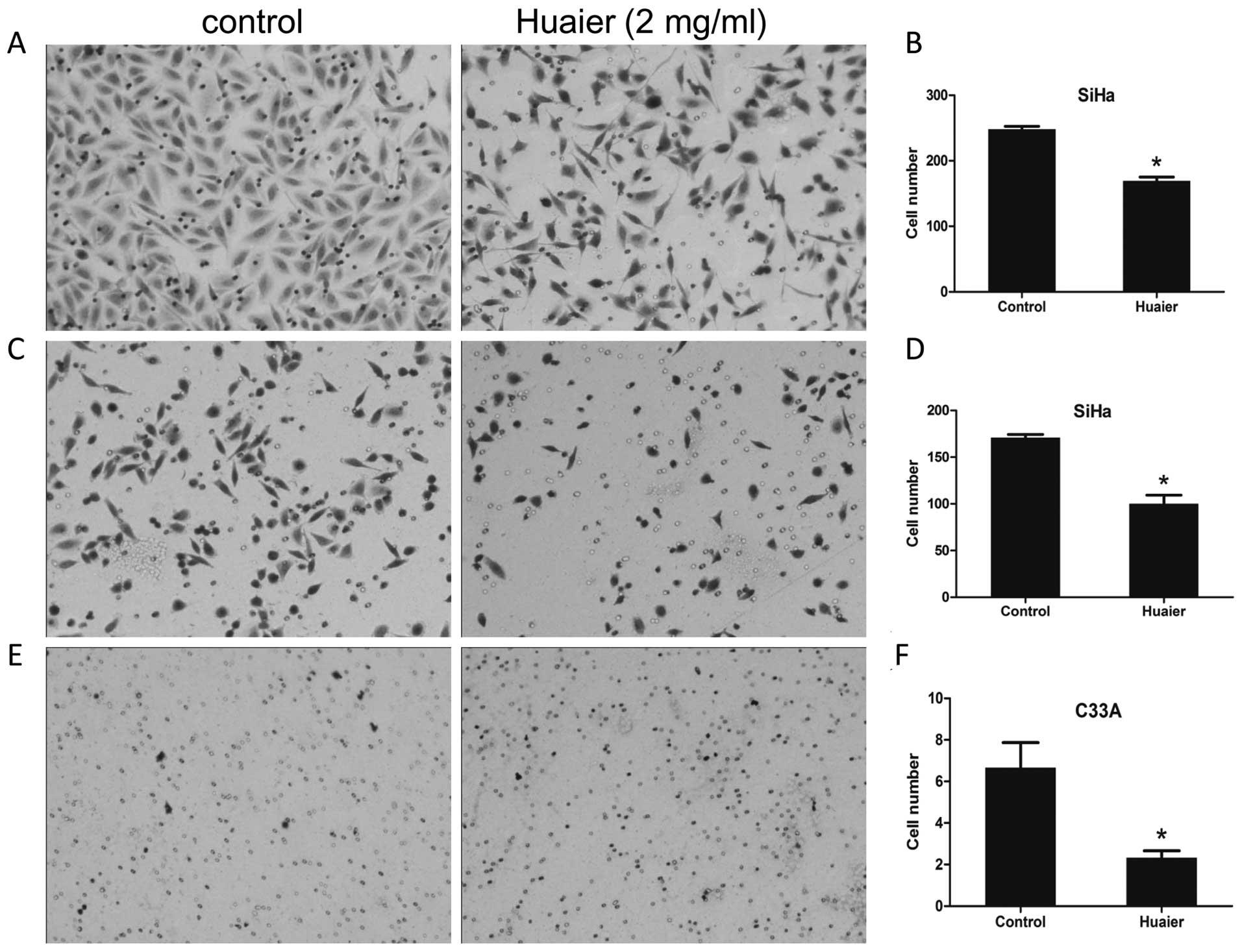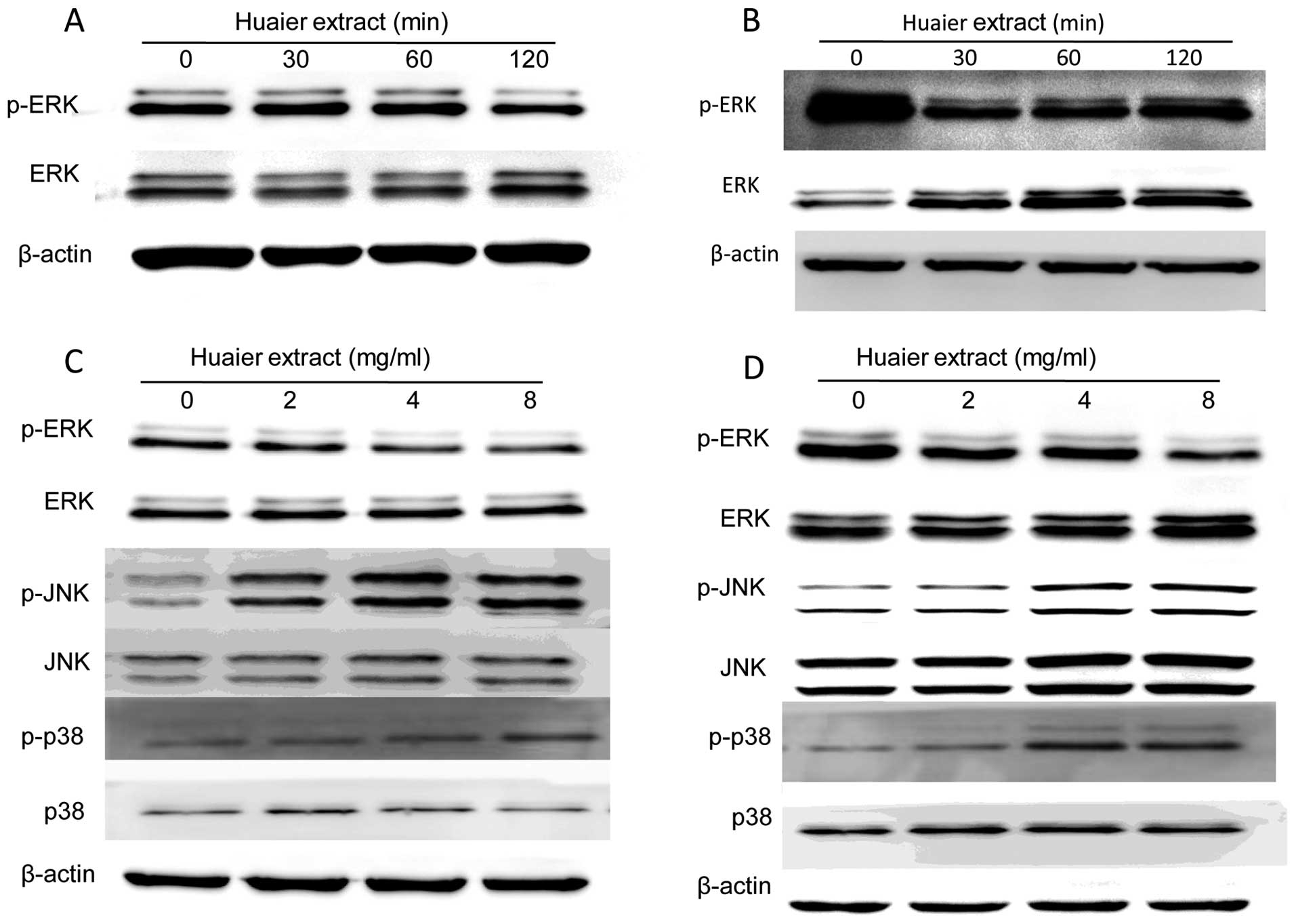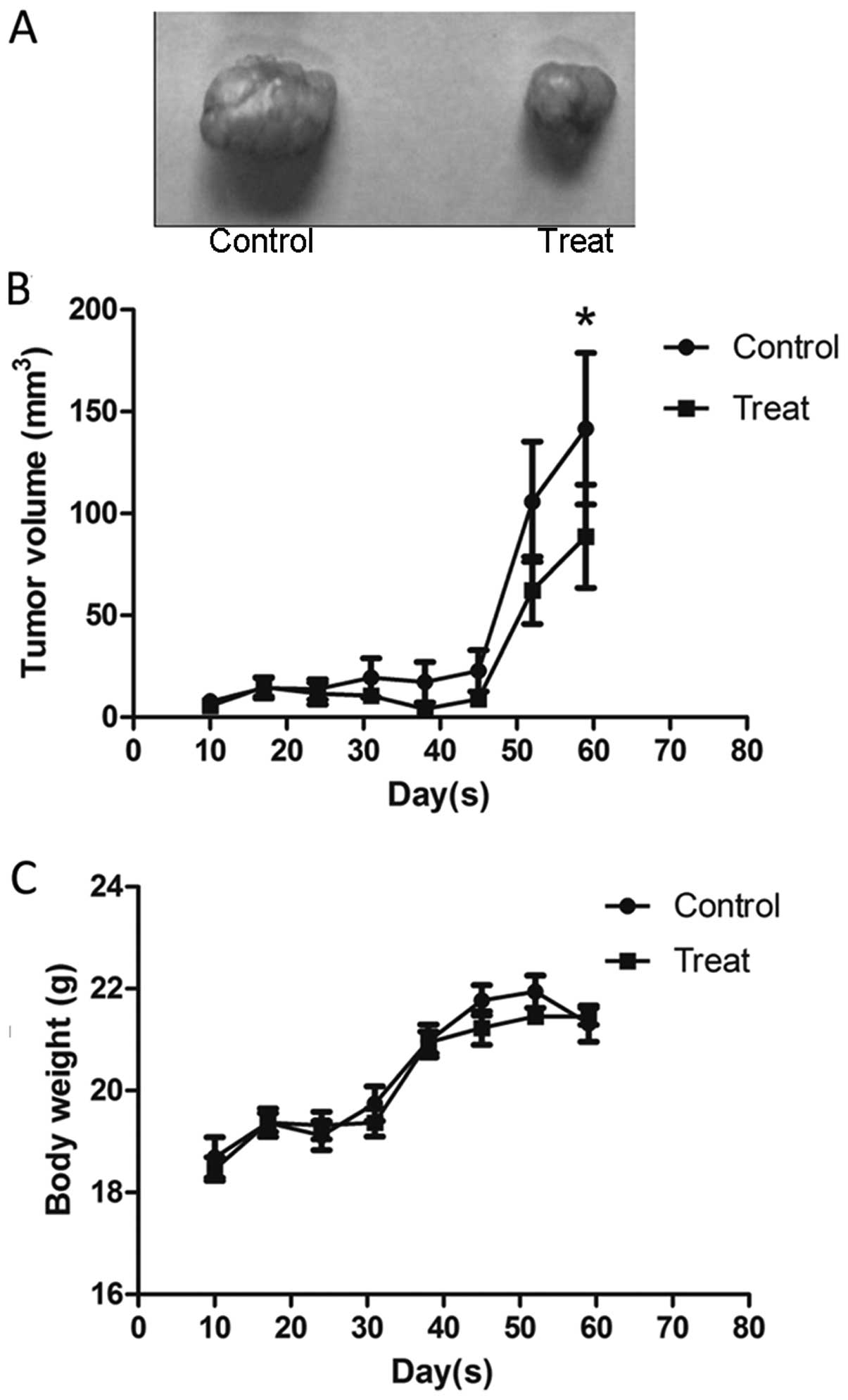Huaier aqueous extract inhibits cervical cancer cell proliferation via JNK/p38 pathway
- Authors:
- Published online on: July 20, 2015 https://doi.org/10.3892/ijo.2015.3094
- Pages: 1054-1060
Abstract
Introduction
Cervical cancer is the fourth most common cancer among women worldwide (1). An estimated 12,360 new cases were diagnosed and 4,020 people died of the disease in the United States in 2014 (2). The most important cause of cervical cancer is human papillomavirus (HPV) persistent infection. HPV16 can be detected in approximately 55–60% of all cases of cervical cancer worldwide (3). Although the current treatment can cure 80–95% of early-stage and 60% of locally advanced cancers, the recurrent and metastatic disease still remains a major problem (4). As the use of concurrent platinum-based chemoradiation often leads to severe toxicity, complementary and alternative medicine (CAM) is recently becoming a popular treatment for various cancers. Many natural products have received increased attention as a potential source of new therapeutic antitumor drugs (5,6).
Huaier is a kind of fungi and has been used for the treatment of various diseases in China for many years. The effective ingredient of Huaier extract is proteoglycan, which contains 41.53% polysaccharides, 12.93% amino acids and 8.72% water (7). The anticancer activity of Huaier extract has been demonstrated in vitro and in vivo in hepatocarcinoma (8–10), breast cancer (7,11,12), colorectal cancer (13), melanoma (14), and ovarian cancer (15). Huaier may cause anticancer effects by various mechanisms, including inhibition of cell growth, induction of apoptosis, inhibition of tumor-induced angiogenesis and inactivation of the epithelial-mesenchymal transition (EMT) (7–15).
However, the effects of Huaier on cervical cancer cells are unknown. In the present study, we investigated the antitumor mechanisms of Huaier in the cervical cancer SiHa cells with HPV-16-positive, and C33A HPV-negative cells.
Materials and methods
Cell lines and cell culture
Two human cervical cancer cell lines SiHa and C33A cells were purchased from the American Type Culture Collection (ATCC, Manassas, VA, USA) and preserved in our laboratory. Both cell types were cultured in minimum essential medium (MEM, Invitrogen, Carlsbad, CA, USA) containing 10% fetal bovine serum (FBS, Haoyang Biological Manufacture Co. Ltd., Tianjin, China) in 5% CO2 at 37°C.
Preparation of Huaier aqueous extract
Electuary ointment of Huaier was provided by Gaitianli Medicine Co. Ltd. (Jiangsu, China). Three grams of the electuary ointment was dissolved in 30 ml of complete medium and was sterilized with 0.22-μm filter to get the 100 mg/ml stock solution for long storage at −20°C (11).
Cell viability assay
Cell viability was determined by 3-(4,5-dimethylthiazol-2-yl)-2,5-diphenyltetrazolium bromide (MTT) assay. SiHa cells (5×103 cells/well) and C33A cells (8×103 cells/well) were seeded in a 96-well plate and incubated for 24 h prior to drug treatment. Following treatment with Huaier at different doses (0–12 mg/ml) for 48 or 72 h, 20 μl of MTT solution was added to each well and the plates were incubated at 37°C for an additional 4 h. The MTT solution was then removed and 100 μl of dimethyl sulfoxide (DMSO) was added to each well to dissolve the precipitated crystals. Cell viability was assessed by measuring absorbance at 570 nm in a microplate reader (Bio-Rad, Hercules, CA, USA). Dose response curves were then created as a percentage of vehicle treated control cells using Excel software.
Colony formation assay
Briefly, SiHa cells were plated at a density of 600 cells/well in 6-well plates and C33A cells were plated at 800 cells/well. After 24 h, the cells were exposed to various concentrations of Huaier (0, 1 and 2 mg/ml) followed by incubation at 37°C in a 5% CO2 incubator for 8 days. This was followed by fixing the colonies with 4% paraformaldehyde and staining with 1% crystal violet.
Cell cycle analysis
Cells were seeded in 6-well plates at a density of 5×105 cells/well and starved in serum-free medium at 37°C. After 24-h starvation, the cells were treated with various concentrations of Huaier extract or complete medium as the negative control for 24 h. The cells were then trypsinized, washed with ice-cold PBS and resuspended in 1 ml staining solution (50 μg/ml PI, 20 μg/ml RNase A). After incubation of 30 min at room temperature, samples were analyzed using a FACSCalibur flow cytometer (BD Biosciences).
Migration and invasion assay
Migration assays were performed using the 24-well transwell chambers which contain polycarbonate filters with 8-μm pores (BD Falcon, Bedford, MA, USA). SiHa cells (10×104 cells/well) and C33A cells (15×104 cells/well) were suspended in 0.2 ml of fresh medium without FBS, then added to the upper well of the chamber. Lower chambers were filled with the culture medium containing 20% FBS as a chemo-attractant with or without 2 mg/ml Huaier. After incubation at 37°C for 24 h, the cells that had migrated to the lower surface were fixed with methanol, stained with 0.2% crystal violet, and counted under an Olympus light microscope. Invasion assay was performed in the same way as the migration assay except that the membrane was coated with Matrigel (BD Biosciences, San Jose, CA, USA). The chambers were incubated at 37°C for 48 h before the cells were fixed.
Western blot analysis
The SiHa and C33A cells were seeded and treated with different concentrations of Huaier extract. At different time-points, cells were harvested and lysed on ice with radioimmunoprecipitation assay (RIPA) buffer (PBS containing 1% NP40, 0.1% SDS, 5 mM EDTA, 0.5% sodium deoxycholate, 1 mM sodium orthovanadate and protease inhibitors). Subsequently, 30 μg of total cellular protein from each sample were separated by 10% SDS-PAGE and electrotransferred onto a polyvinylidene fluoride (PVDF) membranes by using a semi-dry blotting apparatus (Bio-Rad). After blocking with 5% non-fat milk, the membrane was incubated overnight at 4°C with the primary antibody and then with horseradish peroxidase-coupled secondary antibody. Signal was detected with enhanced chemiluminescence (ECL) (Perkin-Elmer Inc.) by Imagequant LAS 4000 (GE Healthcare, Japan). The first antibodies used included β-actin (GeneTex) and three MAPKs (ERK, JNK and p38) antibodies (Cell Signaling Technology).
Animal experiments
The present study was approved by the institutional guidelines of the Animal Care and Use Committee at Shandong University. Fourteen BALB/c nu/nu female mice, 4–6-week-old, were purchased from Huafukang experimental animal limited company and housed within a dedicated SPF facility at Laboratory Animal Center of Qilu Hospital. SiHa cells (4×106) were subcutaneously injected into the right flank of each mouse. Then, the mice were randomly divided into 2 groups (n=7 mice/group). After 2 days, each mouse was given 100 μl solution containing 50 mg Huaier extract (test group) or medium only (control group) by gavage daily. Tumors were measured once a week with a digital caliper. Tumor volume (mm3) was determined by the length (a) and the width (b) as V=ab2/2. After 59 days, the mice were surgically excised, weighed.
Statistical evaluation
SSPS 16.0 software was used for statistical analysis, and Student's t-test was used to analyze the statistical difference. P<0.05 was set as a significant difference. Results are reported as mean ± standard deviation (SD).
Results
Huaier causes cell morphology changes and inhibits cell viability in both SiHa and C33A cells
Morphological changes of SiHa and C33A cells induced by Huaier were observed (Fig. 1). Both cells were treated with various concentrations (0, 2 and 4 mg/ml) of Huaier extract for 72 h. Compared with the untreated cells, the majority of the Huaier-treated SiHa cells changed from spindle to star-shaped with sharp outlines, some of which become the special ‘wiredrawing' morphology. However, most of the C33A cells did not show obvious changes and were non-viable.
In colony formation assay, Huaier at concentrations of 1 and 2 mg/ml significantly inhibit the colony forming abilities of both SiHa and C33A cell. After 8 days continuous culture with Huaier, the colony forming ability of SiHa cells was reduced to 67.6 and 25.4% relative to untreated cells, respectively (Fig. 2A and B). C33A cells exhibited even more decrease in colony formation, and the number of colonies that formed after 8-day treatment was reduced to 37.3 and 0%, respectively (Fig. 2C and D).
According to the MTT assay (Fig. 2E and F), the proliferation of both SiHa and C33A cells was inhibited after treatment with different concentrations of Huaier for 48 and 72 h. The C33A cells were more sensitive to the Huaier treatment than SiHa cells. The IC50 values in SiHa and C33A cells treated with Huaier for 48 h were 5.20 and 3.95 mg/ml, respectively. In addition, a sharp decrease in cell viability was observed when the cells were treated with 6 mg/ml Huaier in C33A cells compared with 8 mg/ml Huaier in SiHa cells.
Huaier induces cell cycle arrest in C33A cells but not in SiHa cells
In order to determine whether the anti-proliferative effect of Huaier attributes to its induction of cell cycle arrest, we treated cells with different concentrations of Huaier for 24 h and analyzed the cell cycle distribution using flow cytometry. As shown in Fig. 3, Huaier treatment increased the percentage of cells at the G2/M phase in a dose-dependent manner in C33A cells, while had no effect on cell cycle in SiHa cells at any of the tested concentrations (data not shown). It indicated that Huaier induced cell arrest at the G2/M phase in HPV-negative cancer cells but not HPV-positive cells.
Cell motility was suppressed due to exposure to Huaier
In this study, the effects of Huaier on the abilities of cell mobility and invasion was determined using the transwell migration assay. The medium containing 20% FBS was added in the lower wells in the absence or presence of 2 mg/ml Huaier extracts, and cells were allowed to migrate for 24 h. As shown in Fig. 4C–F, the abilities of migration of both SiHa and C33A cells were significantly inhibited in the presence of Huaier. The number of migrated SiHa cells in the treated group was 170.67±6.11 relative to 116.00±16.00 of untreated control (P=0.0020) (Fig. 4C and D), and the number of migrated C33A cells in the treated group was 2.33±0.57 compared with the control cells (6.67±2.08, P=0.0255) (Fig. 4E and F). Using the same manner as the mobility assay except utilizing Matrigel-coated inserts with 8-μm pore size, the invasive potential of Huaier-treated and untreated SiHa cells was compared (Fig. 4A and B). It revealed that the number of cells invading through the Matrigel-coated membrane upon treatment with Huaier was significantly less than that of the untreated control (169.33±10.06 versus 248.00±8.00, P=0.0004). C33A cells have been reported to be poorly invasive cells (16), therefore, we did not perform an invasive assay in C33A cells.
Huaier may exert its anti-cervical cancer activity via MAPK signaling pathways
To confirm whether MAPK signaling pathways are involved in the regulation of cervical cancer cell proliferation and motility induced by Huaier, the activities of three major members including the extracellular signal-regulated kinase (ERK), the c-Jun NH2-terminal kinase (JNK) and the p38-MAPK were examined by western blotting. It was shown that the levels of phosphorylated ERK (p-ERK) in both cells treated with Huaier extract were decreased in a time-dependent manner (Fig. 5A and B). Furthermore, the expression of p-ERK in SiHa cells was greatly reduced at 120 min after incubation with 8 mg/ml Huaier, while the sharp reduction in C33A cells occurred at 30 min. Therefore, we investigated the changes of p-ERK in SiHa and C33A cells treated with various concentration of Huaier at 120 and 30 min, respectively. The results showed that Huaier treatment downregulated the phosphorylation of ERK without affecting overall ERK expression levels (Fig. 5C and D). On the other hand, the expression of phosphorylated JNK (p-JNK) and phosphorylated p38 (p-p38) was increased with treatment of increasing concentrations of Huaier (0, 2, 4 and 8 mg/ml) in both SiHa and C33A cells (Fig. 5C and D).
Huaier inhibits tumor growth in vivo
To further assess the effect of Huaier on tumor growth in vivo, the SiHa cell subcutaneous tumor model was established in BALB/c nu/un mice. Two days after the cells were subcutaneously injected into the mice, Huaier was administered to the mice by gavage at a concentration of 2.5 g/kg per day for 3 weeks. Data analysis was performed by considering the tumor size at 7-day intervals. As shown in Fig. 6B, a slight reduction in tumor volume in the mice treated with Huaier occurred one week after the last gavage and the significant reduction was found four weeks later, compared with the untreated group (141.57±98.44 versus 88.71±66.97 mm3, P=0.0093). Furthermore, there was no change in mouse body weight during the experiment (Fig. 6C). Taken together, our data suggest that Huaier is a potent suppressor of cervical cancer growth, with no apparent signs of toxicity.
Discussion
Traditional Chinese medicines have attracted increasing attention due to their promising anticancer potential. Among them, Huaier extracts have been demonstrated to be effective for many cancers including hepatocarcinoma (8–10), breast cancer (7,11,12), and ovarian cancer (15). However, little is known about its effects on cervical cancer and its anticancer mechanism is still not clear. In the present study, we demonstrated the inhibitory effects of Huaier extract on human cervical cancer growth in vitro and in vivo, and investigated the possible mechanisms of action involved. We have provided evidence that Huaier can inhibit the proliferation of cervical cancer cells via the JNK/p38 pathway.
A previous study indicated that Huaier could inhibit cell proliferation by inducing apoptosis (7). However in the present study we found that Huaier treatment in cervical cancer cells did not work in the same way as other cancer cells (data not shown). Our western blot results showed that p-JNK and p-p38 increased in a dose-dependent manner with the treatment of Huaier. It is known that JNK and p38 are members of mitogen activated protein kinase (MAPK) family which are involved in many cellular responses such as proliferation, differentiation and apoptosis. Their activation is induced by several stress stimuli (i.e., oxidative stress, UV radiation, hyperosmosis, and inflammatory cytokines) (17). Activation of both p-JNK and p-p38 was also observed in case of a few other anticancer agents such as Aplidin™ (18), adaphostin (19) and Abrus precatorius (20).
Data show that some anticancer agents modulate JNK activity followed by various pathways including: i) the pro-apoptotic effect; ii) regulation of cell cycle arrest; iii) autophagy. The first pathway has been considered an important process inducing cell death and several drugs in clinical use have been shown to play an role in this manner, for example etoposide, paclitaxel, and Taxol (18). However, our study showed that Huaier induced an accumulation of C33A cells in the G2/M phase of the cell cycle and a decrease in the population of cells in the G1 phase, but not in SiHa cells. These data demonstrated that Huaier-induced cell death was mediated by the cell cycle process, which may in turn be partly regulated by the JNK/p38 pathway. In our study, the cell cycle arrest was observed only in C33A cells treated with Huaier which are HPV-negative. Therefore, we speculated that Huaier may inhibit the growth of HPV-positive tumor cells via other mechanisms than the pro-apoptotic process and cell cycle arrest. More cell lines need to be studied to elucidate the phenomena.
Migration assay and invasion assay were used to evaluate tumor cell motility. Our results showed that Huaier significantly inhibited the migration and invasion in SiHa cells, and migration in C33A cells. In order to reveal the potential signaling pathways underlying the anti-metastasis activity of Huaier extract, we investigated the expression of ERKs. The ERK1 and ERK2 (ERK1/2) are copiously present in all human tissues which have >80% amino acid identity (21). It is well accepted that the ERK pathway plays a significant role in MMP regulation which facilitates tumor cell migration and invasion. In this study, we found that the levels of p-ERK in cervical cancer SiHa and C33A cells decreased by Huaier treatment in a time- and dose-dependent manner. The result suggested that Huaier suppressed motility of cervical cancer cells via downregulation of p-ERK.
In conclusion, our study showed that Huaier extract had an inhibitory effect on cell proliferation in cervical cancer cells via JNK/p38 pathway. We also revealed that cell cycle was arrested in G2/M phase induced by the activation of p-JNK and p-p38 in HPV-negative cells. In HPV-positive cells Huaier extract can also play an important role in cell proliferation and motility, however, the mechanism is still not clear. Further studies should be performed to clarify whether or not Huaier extract can be used as an anti-HPV agent.
Acknowledgements
This study was supported by the National High Technology Research and Development Program (‘863' Program) of China (2014AA020605, 2012AA02A507), National Natural Science Foundation of China (81272857), National Science and Technology Project (2015BAI13B05).
References
|
Kamangar F, Dores GM and Anderson WF: Patterns of cancer incidence, mortality, and prevalence across five continents: Defining priorities to reduce cancer disparities in different geographic regions of the world. J Clin Oncol. 24:2137–2150. 2006. View Article : Google Scholar : PubMed/NCBI | |
|
Siegel R, Ma J, Zou Z and Jemal A: Cancer statistics, 2014. CA Cancer J Clin. 64:9–29. 2014. View Article : Google Scholar : PubMed/NCBI | |
|
de Sanjose S, Quint WG, Alemany L, Geraets DT, Klaustermeier JE, Lloveras B, Tous S, Felix A, Bravo LE, Shin HR, et al; Retrospective International Survey and HPV Time Trends Study Group. Human papillomavirus genotype attribution in invasive cervical cancer: A retrospective cross-sectional worldwide study. Lancet Oncol. 11:1048–1056. 2010. View Article : Google Scholar : PubMed/NCBI | |
|
Cornelio DB, Roesler R and Schwartsmann G: Emerging therapeutic agents for cervical cancer. Recent Pat Anticancer Drug Discov. 4:196–206. 2009. View Article : Google Scholar : PubMed/NCBI | |
|
Munagala R, Kausar H, Munjal C and Gupta RC: Withaferin A induces p53-dependent apoptosis by repression of HPV oncogenes and upregulation of tumor suppressor proteins in human cervical cancer cells. Carcinogenesis. 32:1697–1705. 2011. View Article : Google Scholar : PubMed/NCBI | |
|
Yang Z, Garcia A, Xu S, Powell DR, Vertino PM, Singh S and Marcus AI: Withania somnifera root extract inhibits mammary cancer metastasis and epithelial to mesenchymal transition. PLoS One. 8:e750692013. View Article : Google Scholar : PubMed/NCBI | |
|
Zhang N, Kong X, Yan S, Yuan C and Yang Q: Huaier aqueous extract inhibits proliferation of breast cancer cells by inducing apoptosis. Cancer Sci. 101:2375–2383. 2010. View Article : Google Scholar : PubMed/NCBI | |
|
Ren J, Zheng C, Feng G, Liang H, Xia X, Fang J, Duan X and Zhao H: Inhibitory effect of extract of fungi of Huaier on hepatocellular carcinoma cells. J Huazhong Univ Sci Technolog Med Sci. 29:198–201. 2009. View Article : Google Scholar : PubMed/NCBI | |
|
Zheng J, Li C, Wu X, Liu M, Sun X, Yang Y, Hao M, Sheng S, Sun Y, Zhang H, et al: Huaier polysaccharides suppresses hepatocarcinoma MHCC97-H cell metastasis via inactivation of EMT and AEG-1 pathway. Int J Biol Macromol. 64:106–110. 2014. View Article : Google Scholar | |
|
Zheng J, Li C, Wu X, Liu M, Sun X, Yang Y, Hao M, Sheng S, Sun Y, Zhang H, et al: Astrocyte elevated gene-1 (AEG-1) shRNA sensitizes Huaier polysaccharide (HP)-induced anti-metastatic potency via inactivating downstream P13K/Akt pathway as well as augmenting cell-mediated immune response. Tumour Biol. 35:4219–4224. 2014. View Article : Google Scholar : PubMed/NCBI | |
|
Wang X, Zhang N, Huo Q and Yang Q: Anti-angiogenic and antitumor activities of Huaier aqueous extract. Oncol Rep. 28:1167–1175. 2012.PubMed/NCBI | |
|
Wang X, Zhang N, Huo Q, Sun M, Dong L, Zhang Y, Xu G and Yang Q: Huaier aqueous extract inhibits stem-like characteristics of MCF7 breast cancer cells via inactivation of hedgehog pathway. Tumour Biol. 35:10805–10813. 2014. View Article : Google Scholar : PubMed/NCBI | |
|
Zhang T, Wang K, Zhang J, Wang X, Chen Z, Ni C, Qiu F and Huang J: Huaier aqueous extract inhibits colorectal cancer stem cell growth partially via downregulation of the Wnt/β-catenin pathway. Oncol Lett. 5:1171–1176. 2013.PubMed/NCBI | |
|
Zhang F, Zhang Z and Liu Z: Effects of Huaier aqueous extract on proliferation and apoptosis in the melanoma cell line A875. Acta Histochem. 115:705–711. 2013. View Article : Google Scholar : PubMed/NCBI | |
|
Yan X, Lyu T, Jia N, Yu Y, Hua K and Feng W: Huaier aqueous extract inhibits ovarian cancer cell motility via the AKT/ GSK3β/β-catenin pathway. PLoS One. 8:e637312013. View Article : Google Scholar | |
|
Shin HJ, Rho SB, Jung DC, Han IO, Oh ES and Kim JY: Carbonic anhydrase IX (CA9) modulates tumor-associated cell migration and invasion. J Cell Sci. 124:1077–1087. 2011. View Article : Google Scholar : PubMed/NCBI | |
|
Cuenda A and Rousseau S: p38 MAP-kinases pathway regulation, function and role in human diseases. Biochim Biophys Acta. 1773:1358–1375. 2007. View Article : Google Scholar : PubMed/NCBI | |
|
Cuadrado A, Garcia-Fernandez LF, Gonzalez L, Suarez Y, Losada A, Alcaide V, Martinez T, Fernandez-Sousa JM, Sanchez-Puelles JM and Munoz A: Aplidin induces apoptosis in human cancer cells via glutathione depletion and sustained activation of the epidermal growth factor receptor, Src, JNK, and p38 MAPK. J Biol Chem. 278:241–250. 2003. View Article : Google Scholar | |
|
Yu C, Rahmani M, Almenara J, Sausville EA, Dent P and Grant S: Induction of apoptosis in human leukemia cells by the tyrosine kinase inhibitor adaphostin proceeds through a RAF-1/MEK/ ERK- and AKT-dependent process. Oncogene. 23:1364–1376. 2004. View Article : Google Scholar | |
|
Behera B, Mishra D, Roy B, Devi KS, Narayan R, Das J, Ghosh SK and Maiti TK: Abrus precatorius agglutinin-derived peptides induce ROS-dependent mitochondrial apoptosis through JNK and Akt/P38/P53 pathways in HeLa cells. Chem Biol Interact. 222C:97–105. 2014. View Article : Google Scholar : PubMed/NCBI | |
|
Reddy KB, Nabha SM and Atanaskova N: Role of MAP kinase in tumor progression and invasion. Cancer Metastasis Rev. 22:395–403. 2003. View Article : Google Scholar : PubMed/NCBI |















